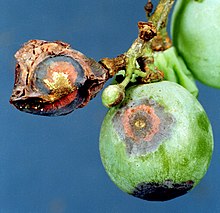Elsinoë ampelina
| Elsinoë ampelina | |
|---|---|
 |
|
| Scientific classification | |
| Kingdom: | Fungi |
| Phylum: | Ascomycota |
| Class: | Dothideomycetes |
| Subclass: | Dothideomycetidae |
| Order: | Myriangiales |
| Family: | Elsinoaceae |
| Genus: | Elsinoë |
| Species: | E. ampelina |
| Binomial name | |
|
Elsinoë ampelina Shear (1929) |
|
| Synonyms | |
|
Gloeosporium ampelophagum (Pass.) Sacc., (1878) |
|
Gloeosporium ampelophagum (Pass.) Sacc., (1878)
Ramularia ampelophaga Pass., (1876)
Sphaceloma ampelinum de Bary, (1874)
Elsinoë ampelina is a plant pathogen, which is the causal agent of anthracnose on grape.
This type of anthracnose affects several plant varieties, including some brambles and wine grapes. Grape anthracnose can be identified by the "bird's eye" lesions on the berries and sunken black or greyish lesions on leaves and shoots. From these lesions, conidia are produced. This disease can be lethal to the plant, either through defoliation and removal of photosynthetic capacity, or through injury to the active regions of the vine. Grape anthracnose is particularly important to the wine industry, as it can decrease quality and quantity of berries produced as well as kill the vine outright, leading to large economic losses, in particular during the middle summer months.
E. ampelina affects two species of Rubus and three species of Vitis. Specifically, E. ampelina affects blackberries, raspberries, mountain grapes, fox or concord grapes, and the European wine grape. Anthracnose diseases can cause disease on a variety of plants, but the primary host for E. ampelina, is grape.
Anthracnose on grape presents itself as lesions on shoots, leaves, and berries. Lesions will first appear on young shoots, showing up as small circular reddish spots that will later become larger and create grey lesions which appear sunken. The lesions will eventually develop margins that are a dark reddish-brown to violet-black color. If left untreated, lesions on shoots will become larger and eventually kill the shoot. While these lesions may be very apparent and easy to identify, they can sometimes be confused for hail damage. Hail damage typically appears on only one side of the plants. Also, anthracnose lesions will have darker and more raised edge.
Anthracnose lesions on leaves and petioles look very similar to those on shoots. However, on leaves, the lesions will have dry grey or white centers that will eventually fall off, leaving a hole. This response by the plant is called a shot-hole. Should the lesions spread and the infection make it into the vascular system of the leaf, the anthracnose will prevent the proper development of the leaf and will lead to malformation or to the drying of the leaf.
...
Wikipedia
